Situated in the heart of the town, this centuries-old inn closed in November 2013. The grade II listed building dates from the 16th century, when it was one of several inns on the High Street, providing refreshment for travellers on the main road north from London. Several of the old inns have survived, but, over the years, have been renamed more than once. In the early 16th century, the Salisbury Arms was known as the Star.
Text about The Star.
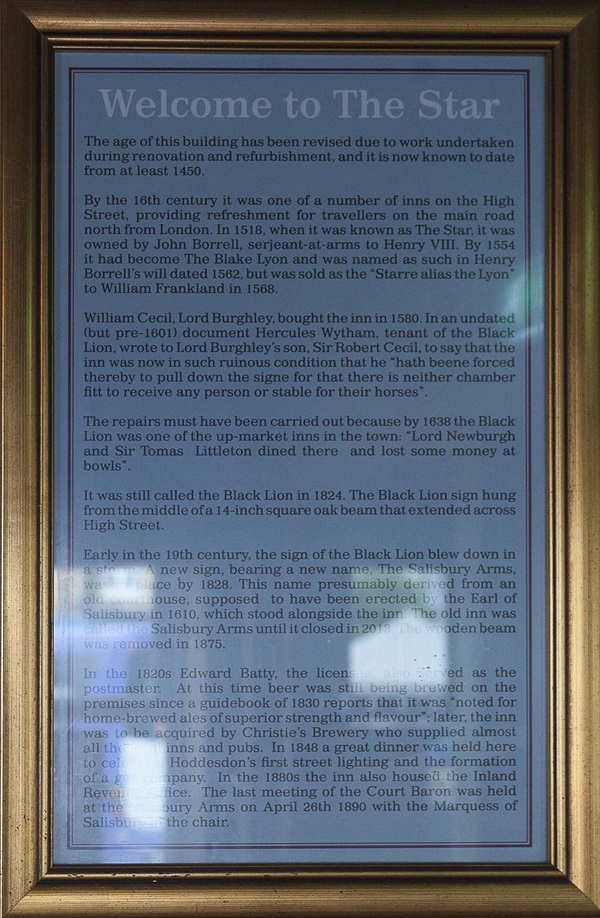
The text reads: The age of this building has been revised due to work undertaken during renovation and refurbishment, and it is now known to date from at least 1450.
By the 16th century it was one of a number of inns on the High Street, providing refreshment for travellers on the main road north from London. In 1518, when it was known as The Star, it was owned by John Borrell, serjeant-at-arms to Henry VIII. By 1554 it had become The Blake Lyon and was named as such in Henry Borrell’s will dated 1562, but was sold as the “Starre alias the Lyon” to William Frankland in 1568.
William Cecil, Lord Burghley, bought the inn in 1580. In an undated (but pre-1601) document Hercules Wytham, tenant of the Black Lion, wrote to Lord Burghley’s son, Sir Robert Cecil, to say that the inn was now in such a ruinous condition that he “hath beene forced thereby to pul down the signe for that there is neither chamber fit to receive any person or stable for their horses”.
The repairs must have been carried out because by 1638 the Black Lion was one of the up-market inns in the town: “Lord Newburgh and Sir Tomas Littleton dined there and lost some money at bowls”.
It was still called the Black Lion in 1824. The Black Lion sign hung from the middle of a 14-inch square oak beam that extended across High Street.
Early in the 19th century, the sign of the Black Lion blew down in a storm. A new name, The Salisbury Arms, was a place by 1828. This name presumably derived from an old courthouse, supposed to have been erected by the Earl of Salisbury in 1610, which stood alongside the inn. The old inn was called Salisbury Arms until it closed in 2013. The wooden beam was removed in 1875.
In the 1820s Edward Batty the licensee, also served as the postmaster. At this time beer was still being brewed on the premises since a guidebook of 1830 reports that it was “noted for home-brewed ales of superior strength and flavour”; later, the inn was to be acquired by Christie’s Brewery who supplied almost all the local inns and pubs. In 1848 a great dinner was held here to celebrate Hoddeson’s first street lighting and the formation of a gas company. In the 1880s the inn also housed the Inland Revenue office. The last meeting of the Court Baron was held at the Salisbury Arms on April 26 1890 with the Marquess of Salisbury in the chair
A plaque documenting the history of The Star.
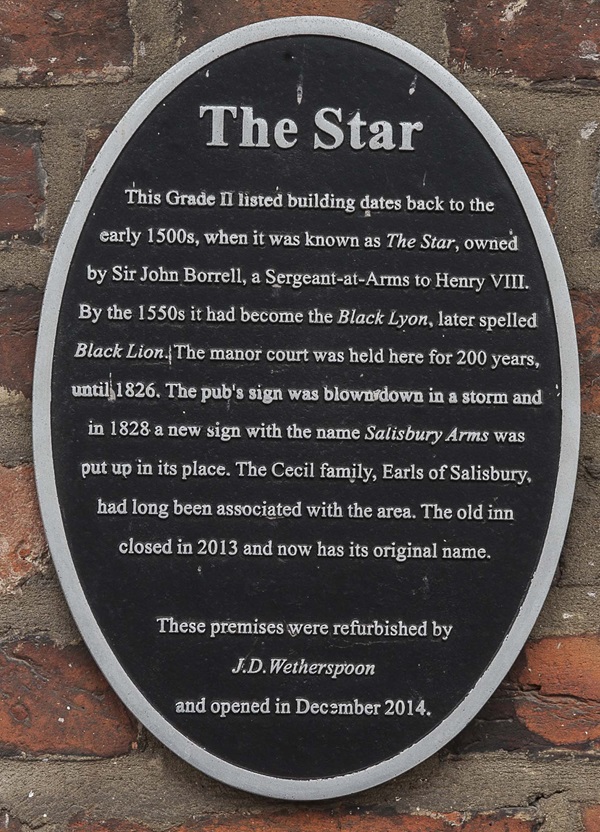
The plaque reads: This grade II listed building dates back to the early 1500s, when it was known as The Star, owned by Sir John Borrell, a Sergeant-at-Arms to Henry VIII. By the 1550s it had become the Black Lyon, later spelled Black Lion. The manor court was held here for 200 years, until 1826. The pub’s sign was blown down in a storm and in 1828 a new sign with the name Salisbury Arms was put up in its place. The Cecil family, Earls of Salisbury, had long been associated with the area. The old inn closed in 2013 and now has its original name.
These premises were refurbished by J D Wetherspoon and opened in December 2014.Photographs and text about the history of the roof beams in the building.
Photographs and text about the history of the roof beams in the building.
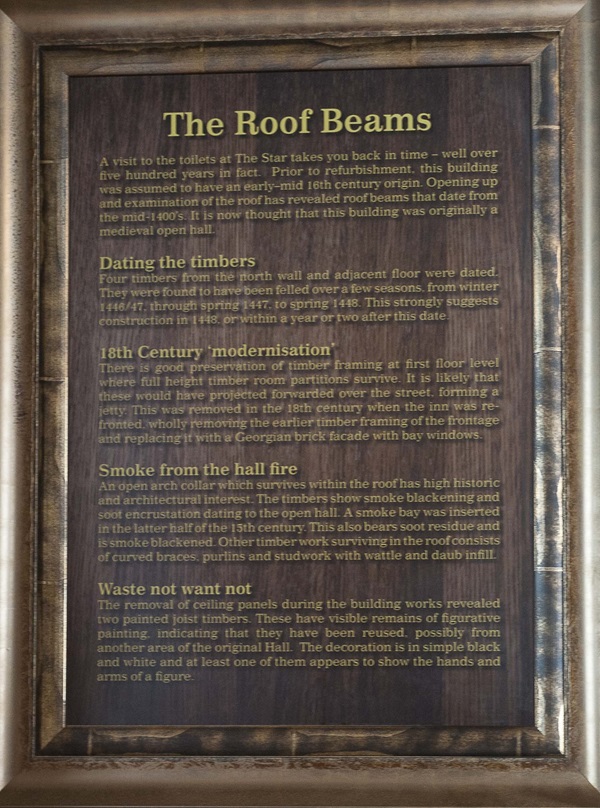
The text reads: A visit to the toilets at The Star takes you back in time – well over five hundred years in fact. Prior to refurbishment, this building was assumed to have an early-mid 16th century origin. Opening up and examination of the roof has revealed roof beams that date from the mid-1400s. It is now thought that this building was originally a medieval open hall.
Dating the timbers
Four timbers from the north wall and adjacent floor were dated. They were found to have been felled over a few seasons, from winter 1446, through spring 1447, to spring 1448. This strongly suggests construction in 1448, or within a year or two after this date.
18th century ‘modernisation’
There is good preservation of timber framing at first floor level where full height timber room partitions survive. It is likely that these would have projected forwarded over the street, forming a jetty. This was removed in the 18th century when the inn was re-fronted, wholly removing the earliest timber framing of the frontage and replacing it with a Georgian brick façade with bay windows.
Smoke from the hall fire
An open arch collar which survives within the proof as high historic and architectural interest. The timbers show smoke blackening and soot encrustation dating to the open hall. A smoke bay was inserted in the latter half of the 15th century. This also bears soot residue and is smoke blackened. Other timber work surviving in the roof consists of curved braces, purlins and studwork with wattle and daub infill.
Waste not want not
The removal of ceiling panels during the building works revealed two painted joist timbers. These have been reused. Possibly from another area of the original hall. The decoration is in simple black and white and at least one of them appears to show the hands and arms of a figure.
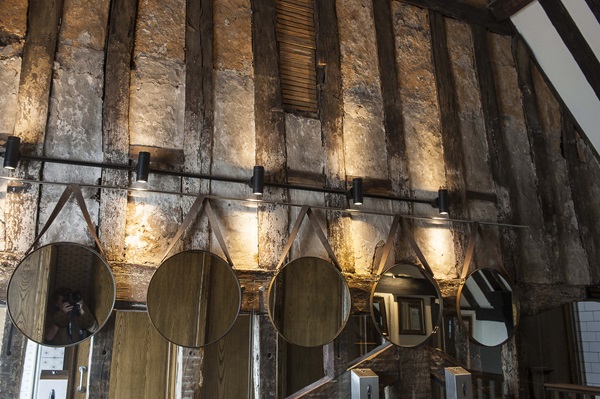
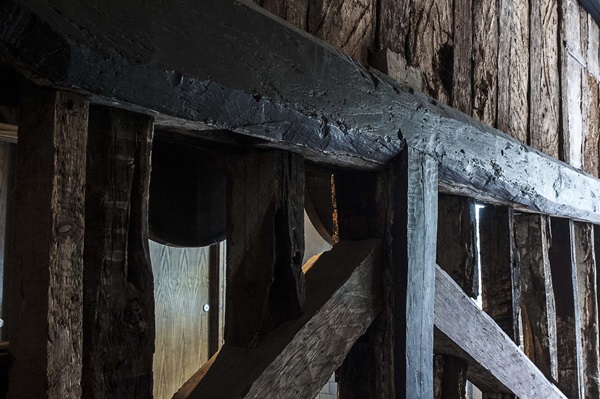
Photographs and text about the building in Elizabethan times.
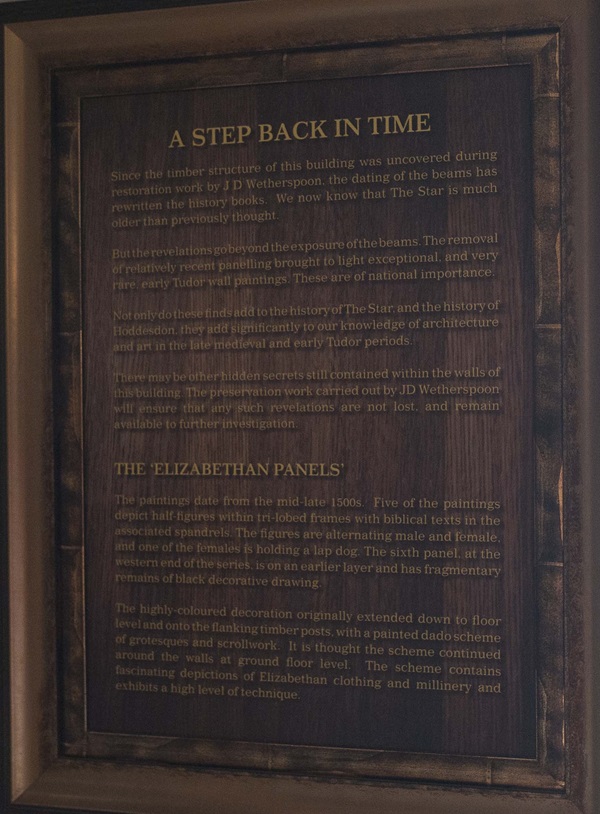
The text reads: Since the Timber structure of this building was uncovered during restoration work by J D Wetherspoon, the dating of the beams has rewritten the history books. We now know that The Star is much older than previously thought.
But the revelations go beyond the exposure of the beams. The removal of relatively recent panelling brought to light exceptional, and very rare, early Tudor wall paintings. These are of national importance.
Not only do these finds add to the history of The Star, and the history of Hoddesdon, they add significantly to our knowledge of architecture and art in the late medieval and early Tudor periods.
There may be other hidden secrets still contained within the walls of this building. The preservation work carried out by J D Wetherspoon will ensure that any such revelations are not lost, and remain available to further investigation.
The paintings date from the mid-late 1500s. Five of the paintings depict half-figures within tri-lobed frames with biblical texts in the associated spandrels. The figures are alternating male and female, and one of the series, is on an earlier layer and has fragmentary remains of black decorative drawing.
The highly-coloured decoration originally extended down to floor level and onto the flanking timber posts, with a painted dado scheme of grotesques and scrollwork. It is thought the scheme continued around the walls at ground floor level/ the scheme contains fascinating depictions of Elizabeth clothing and millinery and exhibits a high level of technique.
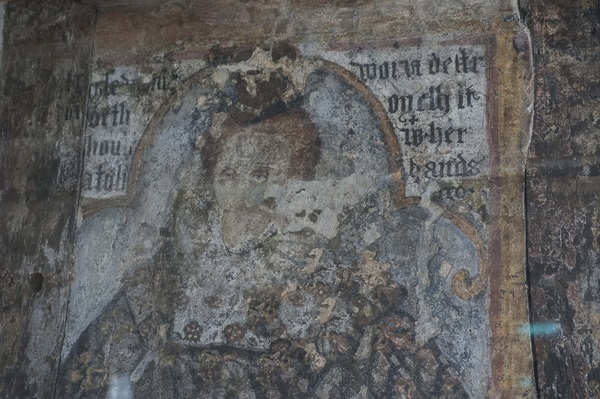
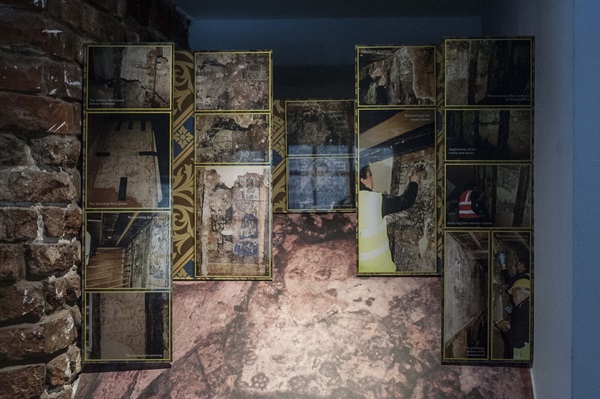
Illustrations and text about William Ellis.
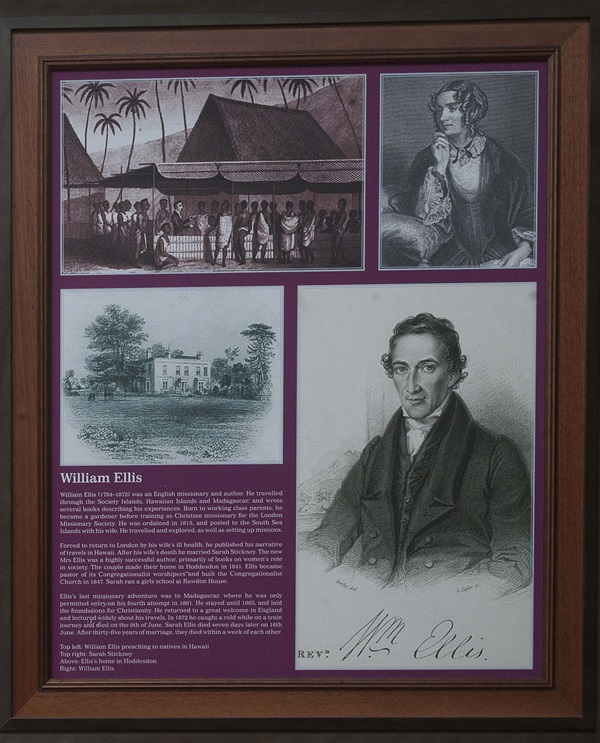
The text reads: William Ellis (1794-1872) was an English missionary and author. He travelled throughout the Society Islands, Hawaiian Islands and Madagascar, and wrote several books describing his experiences. Born to working class parents, he became a gardener before training as Christian missionary for the London Missionary Society. He was ordained in1815, and explored, as well as setting up missions.
Forced to return to London by his wife’s ill health, he published his narrative of travels in Hawaii. After his wife’s death he married Sarah Stickney. The new Mrs Ellis was a highly successful author, primarily of books on women’s role in society. The couple made their home in Hoddesdon in 1841. Ellis became pastor of its Congregationalist worshipers and built the Congregationalist Church in 1847. Sarah ran a girls school at Rawdon House.
Ellis’s last missionary adventure was to Madagascar, where he was only permitted by entry on his fourth attempt in 1861. He stayed until 1865, and laid the foundation for Christianity. He returned to a great welcome in England and lectured widely about his travels. In 1872 he caught a cold while on a train journey and died on the 9 of June. Sarah Ellis died seven days later on 16 June. After thirty-five years of marriage, they died within a week of each other.
Top left: William Ellis preaching to the natives in Hawaii
Top right: Sarah Stickney
Above: Ellis’s home in Hoddesdon
Right: William Ellis.
Photographs, a print and text about Hugh Paddick.
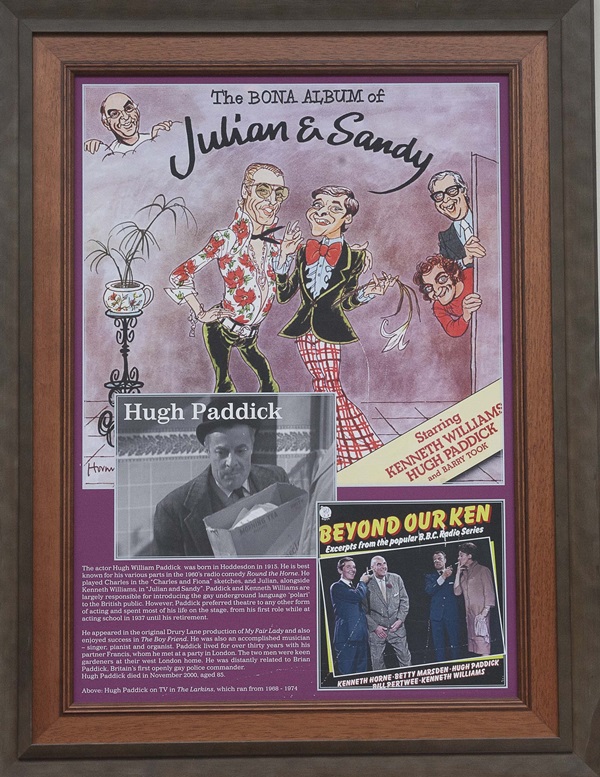
The text reads: The actor Hugh William Paddick was born in Hoddesdon in 1915. He is best known for his various parts in the 1960s radio comedy Round the Horne. He played Charles in the Charles and Fiona sketches, and Julian, alongside Kenneth Williams, in Julian and Sandy. Paddick and Kenneth Williams are largely responsible for introducing the gay underground language ‘polari’ to the British public. However, Paddick preferred theatre to any other form of acting and spent most of his life on the stage, from his first role while at acting school in 1937 until his retirement.
He appeared in the original Drury Lane production of My Fair Lady and also enjoyed success in The Boy Friend. He was also an accomplished musician-singer, pianist and organist. Paddick lived for over thirty years with his partners Francis, whom he met at a party in London. The two men were keen gardeners at their west London home. He was distantly related to Brian Hugh Paddick died in November 2000, aged 85.
Illustrations and text about historical activities at The Star.
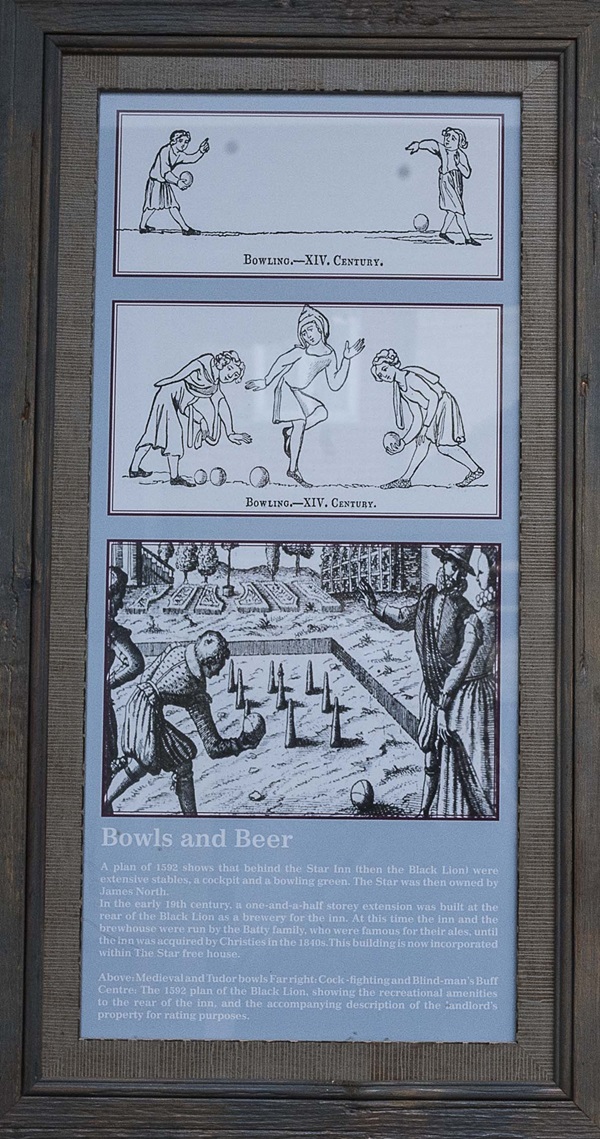
The text reads: A plan of 1592 shows that behind The Star Inn (then The Black Lion) were extensive stables, a cockpit and a bowling green. The Star was then owned by James North.
In the early 19th century, a one-and-a-half storey extension was built at the rear of the Black Lion as a brewery for the inn. At this time the inn and the Brewhouse were run by the Batty family, who were famous for their ales, until the inn was acquired by Christies in the 1840s. This building is now incorporated within The Star free house.
Above: Medieval and Tudor bowls
Far right: Cock-fighting and Blind-man’s Buff
Centre: The 1592 plan of the Black Lion, showing the recreational amenities to the rear or the inn, and the accompany description of the landlord’s property for rating purposes.
Photographs and text about Hoddesdon Town FC.
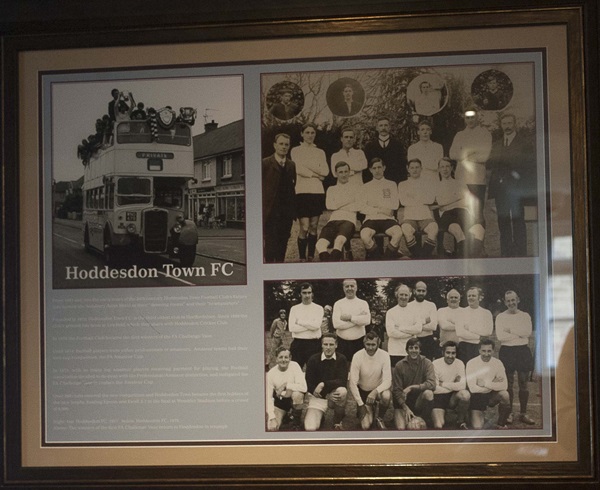
The text reads: From 1881 and into the early years of the 20th century, Hoddesdon Town Football Club’s fixture lists named the Salisbury Arms Hotel as their ‘dressing rooms’ and their ‘headquarters’.
Founded in 1879, Hoddesdon Town FC is the third oldest club in Hertfordshire. Since1899 the club’s ground has been at Lowfield, which they share with Hoddesdon Cricket Club.
In 1975 the football club became the first winners of the FA Challenge Vase.
Until 1974, football players were either professionals or amateurs. Amateur teams had their own competition, the FA Amateur Cup.
In 1974, with so many top amateur players receiving payment for playing, the Football Association decided to do away with professional/amateur distinction, and instigated the FA Challenge Vase to replace the Amateur Cup.
Over 200 clubs entered the new competition and Hoddesdon Town became the first holders of the trophy, beating Epsom and Ewell 2-1 in the final at Wembley Stadium before a crowd of 9,000.
Right: top, Hoddesdon FC, 1991, below, Hoddesdon FC 1975
Above: The winners of the first FA Challenge Vase return to Hoddesdon in triumph.
Photographs and text about Christie’s Brewery.
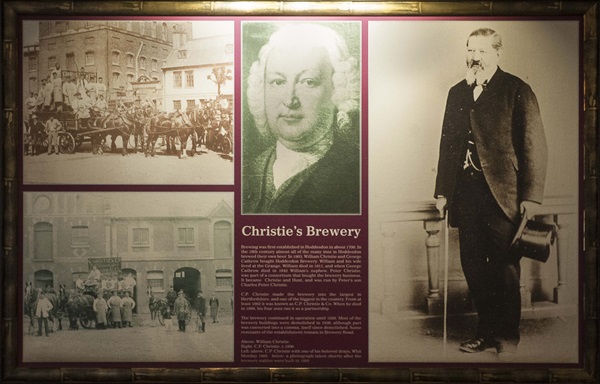
The text reads: Brewing was first established in Hoddesdon in about 1700. In the 18th century almost all of the many inns in Hoddesdon brewed their own beer. In 1803, William Christie and George Cathrow bought Hoddesdon Brewery. William and his wife lived at the George, William died in 1811, and when George Cathrow died in 1842 William’s nephew, Peter Christie, was part of a consortium that bought the brewery business. It became Christie and Hunt, and was run by Peter’s son Charles Peter Christie.
CP Christie made the brewery into the largest in Hertfordshire, and one of the biggest in the country. From at least 1862 it was known as C P Christie & Co. When he died in 1898, his four sons ran it as a partnership.
The brewery continued in operation until 1928. Most of the brewery buildings were demolished in 1930, although part was converted into a cinema, itself since demolished. Some remnants of the establishment remain in Brewery Road.
Above: William Christie
Right: CP Christie, c1890
Left: above, CP Christie with one of his beloved drays, Whit Monday 1895, below, a photograph taken shortly after the brewery stables were built in 1889.
A photograph of CP Christie inspecting brewery waggons in front of the Clock House, c1895.
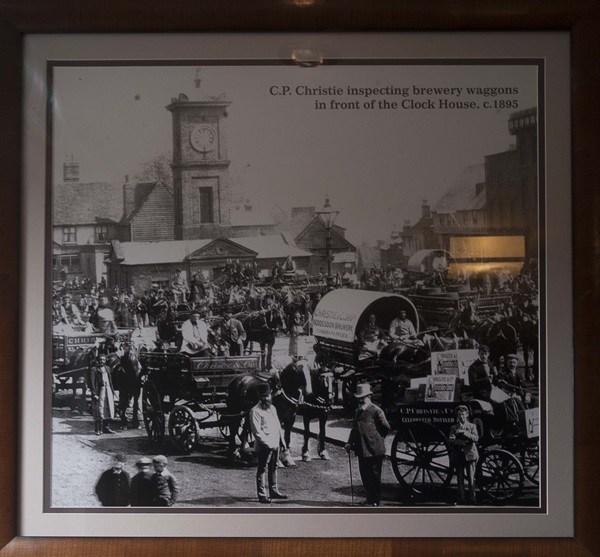
A photograph of a Salisbury Arms coach outing, 1905.
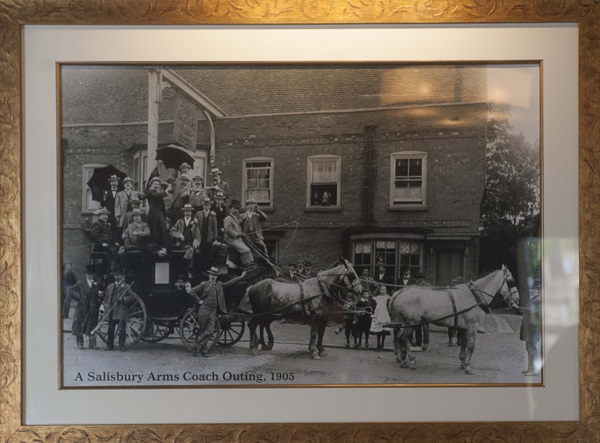
A photograph of CP Christie with some of his employees and a decorated dray prepared for the Whit Monday parade, c1890.
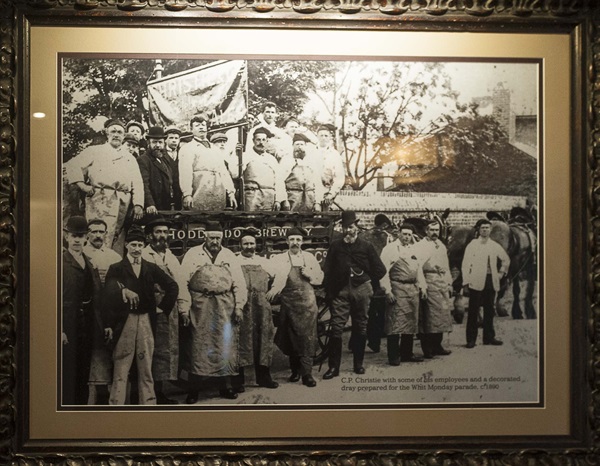
A painting entitled Golden Prospect, by Anna Styrc.
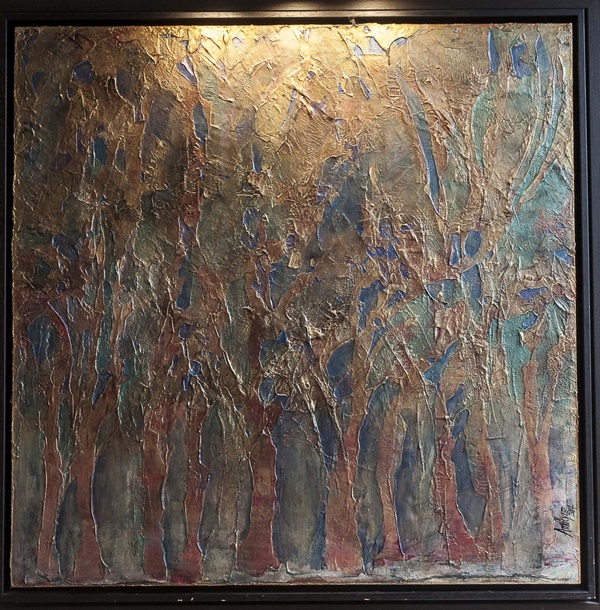
A painting entitled Passing Through, by Mick Brown.
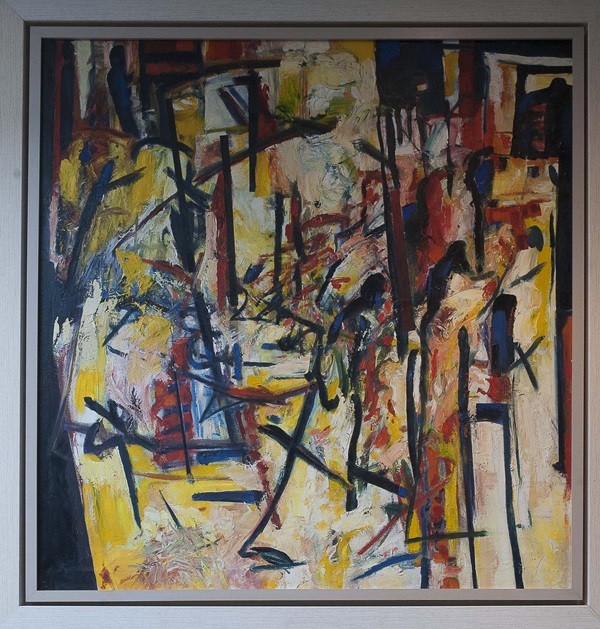
External photograph of the building – main entrance.
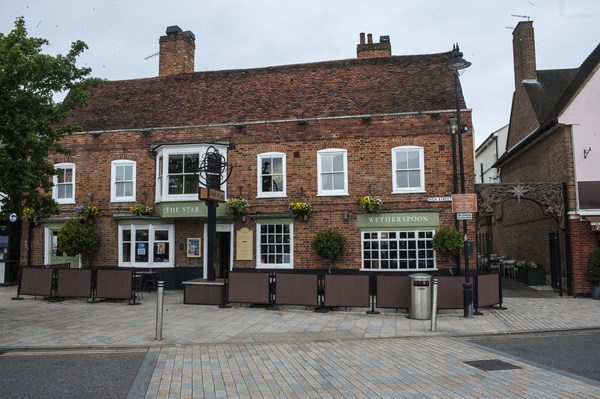
Extract from Wetherspoon News Spring 2017.
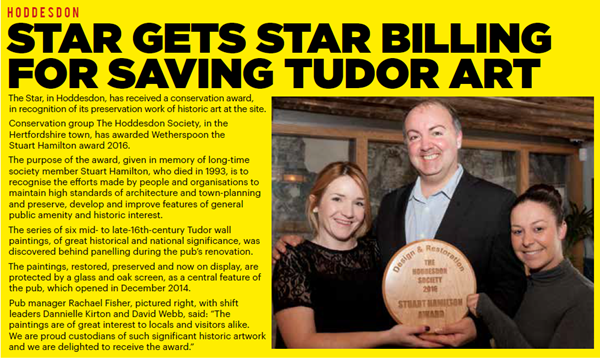
If you have information on the history of this pub, then we’d like you to share it with us. Please e-mail all information to: pubhistories@jdwetherspoon.co.uk